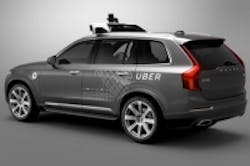Uber to put self-driving cars on the road this month
Back in the beginning of 2015, we reported that Uber wasworking with Carnegie Mellon University on the development of self-driving cars. Flash forward to this month, and Uber is set to deploy a fleet of autonomous vehicles on the road in Pittsburgh.
The vehicles, which are custom Volvo XC90s, can be hailed by Uber customers in downtown Pittsburgh, according toBloomberg. The autonomous vehicles—which will still have humans in the driver’s seat—are equipped with a suite of sensors including cameras, lasers, radar, and GPS sensors to navigate passengers from pickup to drop-off. Volvo Cars has thus far delivered a handful of vehicles of the 100 due by the end of the year. Uber and Volvo previously signed a pact to spend $300 million to develop a fully autonomous car that will be ready for the road by 2021.
Uber also plans to partner with several other automakers as it races to recruit more engineers and outpace companies such as Google in the race to develop the first fully autonomous car. Last month, Uber acquired Otto, a 91-employee driverless truck startup that was founded earlier this year, and includes engineers from a number of big-name tech companies, including Google, Apple, and Tesla. Terms of the deal were not disclosed, but a person familiar with the deal told Bloomberg that if targets are met, it would be worth 1% of Uber’s most recent valuation, or approximately $680 million. Otto employees will receive 20% of any profits Uber earns from building an autonomous trucking business.
Travis Kalanick, CEO of Uber, commented on the news: "The minute it was clear to us that our friends in Mountain View were going to be getting in the ride-sharing space, we needed to make sure there is an alternative [self-driving car]," he said in the article. "Because if there is not, we’re not going to have any business.” Developing an autonomous vehicle, he adds, "is basically existential for us." (Google also invests in Uber through Alphabet’s venture capital division, GV.)
For now, Uber customers in Pittsburgh will request cars as they normally would, and will be paired with a driverless car at random. Trips will be free for the time being, rather than the standard local rate of $1.05 mile. Eventually, prices in driverless cars will be cheaper than in a private car, notes Kalanick.
View theBloomberg article.
Share your vision-related news by contactingJames Carroll, Senior Web Editor, Vision Systems Design
To receive news like this in your inbox, click here.
Join ourLinkedIn group | Like us on Facebook | Follow us on Twitter
Learn more: search the Vision Systems Design Buyer's Guide for companies, new products, press releases, and videos
About the Author

James Carroll
Former VSD Editor James Carroll joined the team 2013. Carroll covered machine vision and imaging from numerous angles, including application stories, industry news, market updates, and new products. In addition to writing and editing articles, Carroll managed the Innovators Awards program and webcasts.
